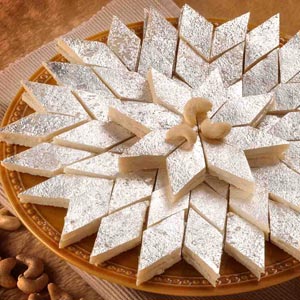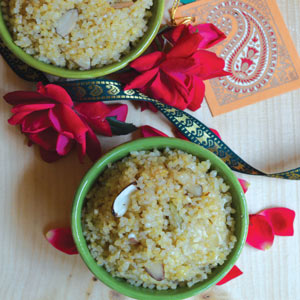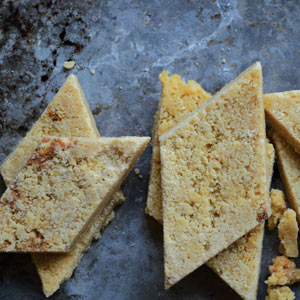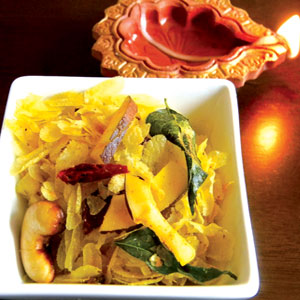Food: Festival Treats

Reflecting on the multicultural roots of her family’s—and India’s—favorite treats, cookbook author NANDITA GODBOLE describes herself as a time-traveling culinary gypsy. Here, she writes about those traditions and shares a few family recipes.
I returned to India this summer in hopes of researching my paternal grandmother, to look for stories that would help me for my next book. She had been gone long enough that everyone’s memories were fading. In what would truly be a race against time, I began to sit by my ailing father's bedside, both of us trying to remember grandma, or Ajji as I called her, as he walked down memory lane one last time. No sooner did he started talking, his words slowly brought his memories of her and his childhood to life.
Over the course of the next few weeks I discovered that ‘our’ family treats were not truly ‘ours.’ Many had come from other families from different parts of the country, sometimes from different subcultures as well. Sometimes embedded in those eats were stories of people and places from elsewhere, far away from our ancestral home, far away in time as well. It felt strange knowing that these ghosts had visited and lived with us through foods once shared with my ancestors, unknowingly cementing their place in our lives as we continued to make these recipes, making them our own in the present day.
Food historians remind us that many of our favorite quintessentially ‘Indian’ fruits, herbs, and spices actually came to India from elsewhere in the world by way of trade. For instance, my favorite Alphonso Mango became what it is, thanks to Portuguese settlers who grafted one variety onto another and created a super fruit. But this summer, what I learned about my own family was even more interesting.
I found out that our New Year tradition of Laapsi, or a sweet cracked wheat pilaf has a family legend attached to it about my Rajput great-grandmother, who may have lived around the 1910’s. An aunt suggested that the mangoes on my grandfather's orchard may have been originally planted by Egyptian or Arab traders in the 1920’s as those mangoes tasted like the ones she had eaten in Egypt a few years ago. I learned that one of my favorite spicy treats Kurdiya, or spicy yogurt stuffed dried chilies, and Coconut Burfi originated in the kitchen of a little mud hut of my paternal grand-aunt who lived in 1930’s in rural Maharashtra near the Maharashtra-Karnataka border. I learned that my own comfort food combination, Fruit Custard with Poori, was originally served in maternal grandfather's restaurant in Bombay in the 1960’s. I discovered that my favorite Christmas treat, Rose Cookies were part of my paternal uncle's kitchen in Nagpur only because of their Portuguese-Catholic house-help, who came to work for them in the 1970’s. And Mysore Paak, now part of my holiday platter via my Delhi-raised Tamilian husband, is welcomed in the family despite the fact that the dish originates in Mysore. All of this makes me feel somewhat of a time-traveling culinary gypsy!
I also came to the realization that that all my favorite treats represented a shared love of local flavors, and that our food was the universal medium where we found comfort and common ground. With this sobering discovery, I put my own life into perspective and began to look at what happens in my own kitchen and among my cookbook readers. How did this long history of culinary integration shape who I became and what I cooked for my family or shared with my readers? The last twenty years of living in the U.S have only added to my appreciation of food, but how did my family comfort foods shape my opinion of the culinary world?
I have observed that many of my cookbook fans in the U.S. come from blended families or are a younger group of second generation Indians. They represent a growing segment of our community that remains slightly disconnected from the ‘homeland’ simply because they grew up elsewhere; some feel as though they cannot relate to the nuances of the Indian cuisine quite as easily and often find it harder to adapt, incorporate, or mold traditional values into their own integrated lives.
Does this kind of disconnect happen because younger individuals are less familiar with family stories that can add a unique ‘flavor’ to these foods? Is it possible that by looking back at the relationships and origins of one’s comfort foods, we could become more accepting of others around us? As the festive season nears, can holiday food platters become a plausible way to come together as a community, and move past differences of language or last names, local and regional allegiances? I believe so.
Over the last 20 years my husband and I have moved into four states, each with a different climate and local culture. Each year we have added new treats to our Diwali celebrations, to enjoy and share with new friends because we cannot be ‘home’ with our family. We miss our family from India more during the holidays, because in comparison to Diwali celebrations in India, suburban American Diwali celebrations feel underwhelming. We want to be ‘home,’ because some part of us thinks of home as somewhere in India. And although over time ‘home’ can become just a state of mind and a place where your loved ones are, some things never change.
In our suburban American kitchen, for many years now, my father's favorite Maharashtrian-styled Chiwda has resided comfortably alongside my great- grandmother's Laapsi for breakfast on Hindu New Year’s Day. And at lunch, we reach over to steal a piece of my husband's Mysore Paak or a variation of my paternal grand-aunt's Coconut Burfi (Mango Coconut Burfi recipe in May 2016 Khabar issue) and miss being around family all over again.
Sadly, my father will never get to read this article: he passed away in July this year. However, I am sure he will be visiting us, if only in spirit, as we relive memories of him and his love of Diwali treats through the foods we prepare during the festive seasons from here on out.
If you would like to be part of our Diwali celebrations, I am including some of our family recipes. And as you make them, enjoy them, and share them, we will become kindred brethren, sharing the joys of the festive season, if only in spirit.
( ) ( ) ( ) ( ) ( ) ( ) ( ) ( ) ( ) ( ) ( ) ( ) ( ) ( ) ( ) ( ) ( )
|
|
FATHER’S FAVORITE CHIWDA
Makes: Twelve 2/3-cup servings
Prep Time: 20 minutes
Cook Time: 5-8 minutes
Ease: Moderately easy
INGREDIENTS
¼ cup oil
1 tsp cumin seeds
3" fresh ginger, grated
12-15 fresh curry leaves
3 fresh jalapeños, finely chopped
2-4 Tbsp raw split channa daal (Bengal gram)
3-4 whole dried red chilies, broken into ¼" pieces
¼ tsp asafoetida powder
¼ tsp turmeric powder
¼ cup raisins (or dried cranberries)
½ cup raw unsalted peanuts, see pre-prep note
½ cup raw unsalted cashews, almonds or other
nuts of choice, see pre-prep note
¼ cup unsweetened dried coconut slices, see
pre-prep note
6 cups dry thin flattened rice (poha) or unsweetened rice puffs (such as Rice Krispies®), see
pre-prep note
2 Tbsp. lime juice
1 tsp salt
2 Tbsp. sugar
PRE-PREP
Dry roast the flattened rice until it is very lightly golden brown. Spread over a paper towel to cool.
Shallow-fry the peanuts, cashews, and coconut slices in 2-3 Tbsp oil. When these begin to turn golden, reduce the heat and remove them from the oil for use later.
METHOD
Heat the oil in a large wok. When the oil is warm but not hot, add cumin seeds, ginger, curry leaves, and chopped jalapeños. Stir vigorously to allow all the flavors to release.
Add the channa daal, dried red chilies, asafoetida powder and turmeric powder, and mix well to avoid burning.
Add the raisins or cranberries and let them soften.
Add the lime juice, salt, and sugar and turn off the heat.
While the oil and spices are still hot, add the reserved peanuts, cashews, and coconut slices, as well as the cooled flattened rice.
Return the wok to a medium-low heat and toss this mixture quickly with two spatulas as one would toss a salad to ensure complete mixing. Remove from heat.
Serve hot, or allow this to cool and store it in an airtight container for up to 4 weeks.
() . () . () . () . () . () . () . () . () . () . () . () . () .

GREAT-GRANDMOTHER'S LAAPSI
Makes: Eight ½-cup servings
Prep Time: 10 minutes
Cook Time: Less than 30 minutes
Ease: Easy
INGREDIENTS
2 Tbsp. ghee
3-4 green cardamom pods
2 cups cracked whole wheat, see pre-prep note
1½ cups water, boiling hot
1/3 cup sugar, adjust to taste
¼ cup almonds, slivered or sliced
PRE-PREP
Rinse the cracked wheat in cold water, drain, and set aside.
METHOD
Heat the ghee in a medium, heavy-bottom saucepan. Turn down the heat to medium low, add the whole cardamom pods to the ghee, and allow them to release their flavors for 1-2 minutes.
Add the rinsed cracked wheat into the ghee. Using a flat spatula, stir continuously for 3-5 minutes until the cracked wheat is glistening and coated with the ghee.
Reduce the heat to low and carefully add the boiling water. Allow the water to boil through and let the cracked wheat cook completely. If it still appears undercooked, add ½ cup more water and let it finish cooking, until all the water is absorbed.
Finally, add the sugar and almonds if using any. Cook until the sugar fully dissolves. Adjust for sweetness with additional sugar, or for creaminess, with milk or heavy cream.
This may be served cold or warm.
<><><><><><><><><><><><><><><>

UMA’S MYSORE PAAK
Makes: Varies
Prep Time: 10 minutes
Cook Time: Less than 30 minutes
Ease: Moderately easy
INGREDIENTS
2 cups sugar
Enough water to wet the sugar
1 cup chickpea flour (besan), sifted and lumps removed, see pre-prep note
2 cups ghee
½ cup chopped nuts for decoration (optional)
2 Tbsp ghee, extra for greasing utensils
PRE-PREP
Roast besan and set aside. Grease a shallow 9” X 9” glass or metal tray, and the underside of a small smooth-bottomed bowl and set both aside. Use a
shallow container to set the batter, to make it easier
to unmold.
METHOD
Place the sugar in a large heavy-bottom saucepan and add just enough water to cover the sugar. Boil this mixture on low until the sugar is completely dissolved and the liquid is clear.
Add the roasted chickpea flour slowly into the sugar syrup. Using a flat tipped spatula, stir the mix vigorously until all the flour is mixed in.
Add the ghee in a steady stream and continue to stir until all the ghee is incorporated. Keep stirring until the heavy batter-like mixture begins to leave the sides of the pan.
Remove from heat and quickly pour the mixture into the greased pan. Immediately smooth out the batter with the greased underside of a bowl, decorate with chopped nuts if desired while the batter is still hot, and cut into desired sized pieces.
Allow this to cool for 30 minutes before removing the pieces from the tray.
Nandita Godbole is the author of A Dozen Ways to Celebrate: Twelve Decadent Feasts for the Culinary Indulgent, a collection of dinner party recipes; and Crack the Code: Cook Any Indian Meal with Confidence, a book of methods for novice chefs and Indian food enthusiasts. Her memoir Not For You: Denial & Comfort Foods will be released next year. Find her on Instagram & Twitter @ currycravings, or through her websites: www.currycravings.com and www.currycravingskitchen.com.
Enjoyed reading Khabar magazine? Subscribe to Khabar and get a full digital copy of this Indian-American community magazine.
blog comments powered by Disqus











